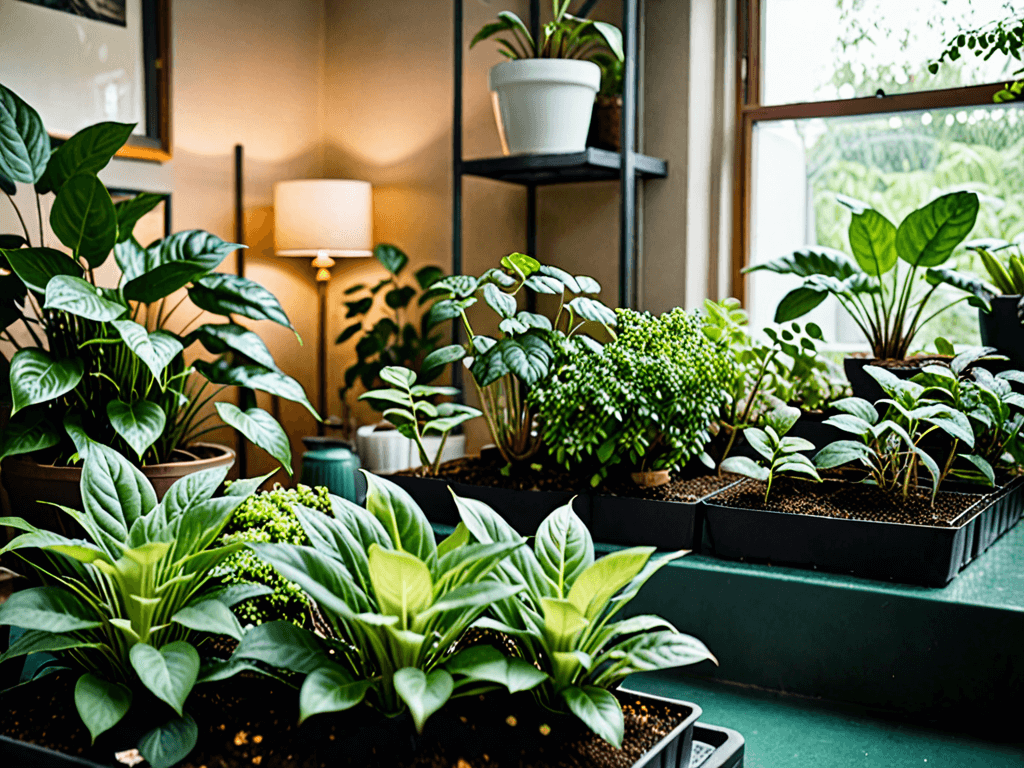Indoor gardening brings the beauty and serenity of nature into your home.
It transforms living spaces into lush, green sanctuaries, boosting your mood and enhancing indoor air quality.
With simple tools and careful plant selection, anyone can enjoy the year-round benefits of indoor gardening.
This guide will help you choose the right plants, maintain plant health, and explore creative gardening projects in any home size.
Benefits of Indoor Gardening
Indoor gardening offers a multitude of benefits that extends beyond mere aesthetics. Improved air quality is one of the most significant advantages, as plants naturally filter pollutants and release oxygen.
Additionally, having greenery indoors can boost mental well-being by reducing stress and promoting a sense of calm.
Engaging with plants also encourages a mindful approach to life, providing a sense of achievement as you nurture living things.
Moreover, growing your own herbs and small vegetables indoors can enhance your diet with fresh produce.
Indoor gardening is an eco-friendly hobby, contributing positively to the environment by supporting green practices and reducing your carbon footprint.
Embracing this green practice can transform your living space into an oasis of tranquility and health.
Essential Tools for Indoor Gardens
To start indoor gardening effectively, you’ll need a selection of essential tools. A sturdy set of hand tools such as trowels, pruners, and shears will help you manage your plants with precision.
Indoor plants require appropriate lighting, so consider investing in LED grow lights to supplement natural sunlight, especially if your space lacks natural light.
Watering cans with long spouts make it easy to reach pots without splashing water everywhere.
For plant nutrition, use potting soil that is specifically designed for indoor plants, ensuring proper drainage and aeration.
Humidity is also crucial; a small humidifier or misting spray can maintain the required moisture levels.
Don’t forget a range of containers and pots tailored to your plant’s size and growth habits.
Finally, use small saucers under pots to catch excess water and protect surfaces.
Choosing the Right Plants
Choosing the right plants is crucial to the success of your indoor garden. Assessing light conditions in your space will help you decide which plants thrive best. Low-light areas are ideal for species like snake plants or pothos, while sun-loving areas suit plants like succulents and herbs.
Consider the size of your space too, opting for smaller plants if you have limited room, or tall varieties like fiddle leaf fig in larger areas.
Another factor is the level of maintenance you’re comfortable with; if you’re time-poor, select low-maintenance varieties like cacti or zz plants.
Also, think about allergens, especially if anyone in your home is sensitive to certain plants.
Indoor gardening should enhance your space, so choose plants that align with your lifestyle and environment.
Indoor Gardening for Small Spaces
Maximizing green spaces in small areas can be challenging, yet indoor gardening is highly adaptable for limited spaces. Using vertical gardening techniques, such as wall planters and hanging pots, can help make the most of available room.
Opt for plants that don’t require much space, like microgreens or herbs, which can thrive on windowsills or small shelves. Consider using multi-tiered plant stands to stack pots, increasing your growing capacity without taking up extra floor space.
Another solution is hydroponic systems, which allow you to grow plants without soil, often in compact units that fit easily on kitchen counters or tabletops. Versatility is key, so choose plants and tools that adapt to various light and space conditions, ensuring you create a lush environment even in the smallest of areas.
Maintaining Indoor Plant Health
Maintaining indoor plant health is vital for a thriving indoor garden.
Start by monitoring your watering schedule; overwatering is a common issue that can lead to root rot.
Use your finger to check soil moisture before watering.
Ensure your plants receive adequate light by placing them near windows or using grow lights as needed.
Humidity is another key factor; mist your plants regularly or use a humidifier to maintain ideal levels, especially in winter months.
Keep an eye out for pests like mites or aphids, which can be controlled with natural remedies such as neem oil or soapy water.
Regular pruning encourages growth and prevents overcrowding, while feeding plants with the right fertilizer ensures they get necessary nutrients.
Seasonal Tips for Indoor Greenery
Caring for indoor plants varies with the seasons. In winter, plants need less water and may benefit from additional humidity due to dry indoor air. Ensure they’re getting as much sunlight as possible by cleaning windows and possibly relocating them to brighter spots.
During spring, promote growth by repotting if necessary and feeding plants with a suitable fertilizer to boost their nutrients.
As summer arrives, water more frequently but watch out for signs of overwatering, as heat can dry soil faster. Shade plants from intense midday sun to prevent leaf scorch.
In the fall, start reducing water and stop fertilizing towards the end of the season as plants enter dormancy. Adjust the care routine based on the plant’s specific needs and environmental changes.
DIY Indoor Gardening Projects
Engaging in DIY indoor gardening projects can unleash creativity and enhance your living space.
Begin with making a mini-herb garden using simple containers like mason jars or tin cans, perfect for kitchen counters.
Crafting a terrarium is another fun project; use a glass bowl or jar filled with small plants and decorative stones.
Vertical gardens are also trending; you can transform a wooden pallet into a living wall with pockets for different plants.
Create a succulent centerpiece for your table by planting varied succulents in a shallow dish with some colored pebbles.
Lastly, upcycle old containers into unique pots with paint or fabric, adding a personal touch and reducing waste.
Common Mistakes to Avoid
Avoiding common mistakes in indoor gardening can ensure your plants thrive.
Overwatering is a frequent issue; plants only need watering when the top inch of soil is dry.
Inadequate lighting is another pitfall; placing too many plants in low-light areas can stunt growth.
It’s important not to overlook plant compatibility—some species release compounds into the soil that can harm others.
Not rotating plants is a mistake as it leads to uneven growth; ensure they are turned periodically for balanced exposure.
Using the wrong potting mix can also hinder plant health; always use a mix suitable for indoor plants to provide proper drainage and nutrition.
Summing Up Indoor Gardening
Indoor gardening offers a wonderful opportunity to bring nature into our homes, enhancing the living space with fresh air and greenery.
Through understanding and applying essential techniques such as choosing the right plants, using proper tools, and avoiding common mistakes, you can ensure your indoor garden thrives.
Embrace DIY projects to creatively utilize small spaces and adapt to seasonal changes for optimal plant health.
With patience and care, your indoor garden can become a cherished part of your home, providing beauty, tranquility, and even fresh produce.
Frequently Asked Questions about Indoor Gardening
What are the easiest plants to grow indoors?
Some of the easiest plants to grow indoors include snake plants, pothos, and succulents.
How often should I water my indoor plants?
Watering needs vary by plant and environment, but a general rule is to water when the top inch of soil feels dry.
Can indoor plants improve air quality?
Yes, many indoor plants can help purify the air by removing toxins and releasing oxygen.
What kind of lighting do indoor plants need?
Most indoor plants prefer bright, indirect light but some can thrive in low-light conditions.
How can I increase humidity for my indoor plants?
You can increase humidity by misting plants, using a humidifier, or placing a tray of water near the plants.
Are there specific tools I need for indoor gardening?
Basic tools include a watering can, pruners, potting soil, and containers.


